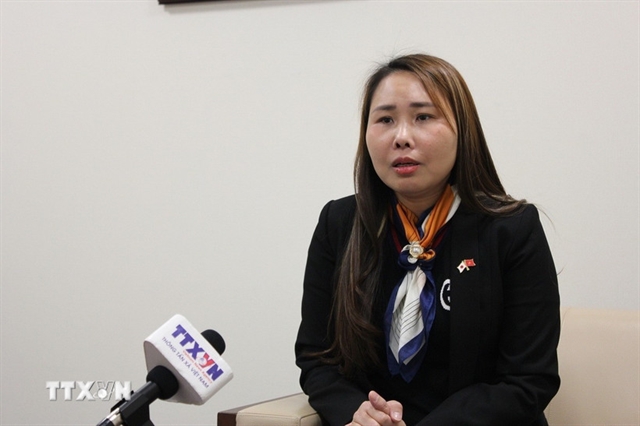 Opinion
Opinion

Naomi Kitahara, United Nations Population Fund (UNFPA) Representative in Việt Nam speaks to Việt Nam News reporter Thu Trang about the country’s work for COVID-19 pandemic prevention and control.

|
| Naomi Kitahara, UNFPA Representative in Việt Nam |
Naomi Kitahara, United Nations Population Fund (UNFPA) Representative in Việt Nam speaks to Việt Nam News reporter Thu Trang about the country’s work for COVID-19 pandemic prevention and control.
What is your assessment about Việt Nam’s work for COVID-19 prevention and control?
Globally, there are nearly 170 million cases and over 3.5 million deaths recorded so far from COVID-19. Given its large population size of 97 million, it is clear that Việt Nam has been extremely successful in containing the pandemic, having recorded so far just over 6,000 cases and less than 50 deaths. UNFPA expresses our deep sympathies to those who suffered from COVID-19 and extends our sincere condolences to those whose family members have lost their lives. My observations in terms of key success factors which Việt Nam should share to the world include: (1) The country has been very much united, and the sense of solidarity and responsibility has been strong across all sectors, communities and people in the combat against the pandemic. Everyone seems to have understood very well what has to be done, and authorities putting in place effective control measures while fully respecting people’s needs; (2) The testing, contact tracing and quarantine procedures have been rigorous and transparent; (3) New communication channels, such as mobile phone text messages, mobile app, and online pages have been fully utilised to deliver information, disseminate alerts, and mobilise communities; and (4) Recognising people’s difficulties to cope with COVID-19, the government provided $2.6 billion for the social protection package. Also very unique and innovative types of assistance was provided to vulnerable populations, as we saw in rice ATM’s and utility subsidies, all of which attracted international attention. So despite the recent surge of COVID-19, I trust that the country will contain COVID-19 very soon.
Despite many efforts, consequences caused by the pandemic are still a big concern. What aspects does the COVID-19 impact on vulnerable populations, and on gender equality?
The COVID-19 pandemic has taken a heavy toll on many countries in the world, including Việt Nam. The pandemic has exacerbated existing inequalities and disproportionately affected vulnerable populations.
The first population group that UNFPA is concerned about due to its particular vulnerability is pregnant women. Given the pressure in the health system, as well as women’s reduced health seeking behaviors due to COVID-19, the modelling analysis conducted by UNFPA estimated that maternal mortality could increase by 44-65 per cent as a negative consequence of the pandemic in Việt Nam. This meant 298-443 additional mothers dying from pregnancy and childbirth a year in Việt Nam from the estimated 677 maternal deaths a year. UNFPA was very much alarmed by this result, as it essentially meant a reversal of developmental gains that Việt Nam has achieved in the past decades in the areas of sexual and reproductive health, and despite the fact that Việt Nam was one of the only few countries in the world which achieved the maternal mortality reduction target of the Millennium Development Goals some years ago.
Second, victims and survivors of gender-based and domestic violence as well as those who are at risk of such violence are very much the central part of UNFPA’s targeted support. It should be fully recognised that the pandemic has led to an increase in violence against women and girls as a result of confinement, job loss, uncertainties, reduced household income, and increased stress levels at home. With COVID-19, it has become more difficult for women to access protection, care and services as well, and often victims and survivors have to stay with the perpetrators at home for a prolonged period of time, making them exceptionally vulnerable. The UNFPA-supported National Study on Violence Against Women, which was conducted in pre COVID-19 year of 2019, already showed that nearly two in three women experienced one or more forms of violence in their life time, and with COVID-19, we estimate that the prevalence of violence against women and girls have become even higher, having observed that the number of calls for help in UNFPA-supported help-lines and hot-lines more than doubled last year.
Moreover, I should say that the pandemic deepened gender inequality even more. For instance, containment measures have increased pressure on women in domestic (and unpaid) care for family members including care for school children and the elderly. Women have been heavily affected in economic sectors that are worst impacted by the crisis (such as manual, retail, hospitality, and informal sectors, which also cannot be performed remotely), often resulting in high unemployment and lower income. In the health sector, care is predominantly provided by nurses and social workers (who are mostly women), including support to COVID-19 patients.
Third, in the context like Việt Nam where population ageing is progressing fast, UNFPA’s attention is also focused on the increased vulnerability of the elderly population, particularly elderly women. People above 60 years old are extremely vulnerable to COVID-19, as their risk of developing severe conditions and fatality is higher. 95 percent of the elderly population have underlying, and chronic, health conditions, which make them susceptible to the negative effect of the pandemic. Social distancing and other COVID-19 related prevention and protection measures could also mean reduced staff availability in institutional care facilities for older persons. And like pregnant women, health and care services have often been interrupted for old people, posing particular challenges for those elderly people with disabilities. Social distancing could also mean isolation of the elderly, making it more difficult to obtain essential information, goods and services.
And lastly, we must not forget the vulnerability of adolescents and youth. Their risks to COVID-19 are often under-estimated, and it is important to recognise that they have also been confronted with multiple shocks including a disruption to education and employment, income loss, greater difficulties in finding a job and accessing health and other public services. Viet Nam currently has the largest number of young people in its history, creating a demographic bonus period for the country’s socio-economic growth, but adolescents and youth are often faced with such life-time challenges in COVID-19. For example, the recent survey pointed out that over one in six young people had stopped working since the onset of the COVID-19 crisis. Young, international migrant workers, had to return to Viet Nam due to COVID-19, often in short notice and without much choice. They too suffer from reintegration to the local market and communities.
Earlier, you stressed the importance of uninterrupted provision of the sexual and reproductive health care under COVID-19 emergency context. Could you explain more about this?
Pregnancy does not stop in emergency or in COVID-19 context. Pregnancy and childbirth are the essential part of people’s lives, and it should not be forgotten even in the face of COVID-19. We fully support that available resources in the health sector have to be mobilised to contain COVID-19, but we also insist that essential sexual and reproductive health care has to continue to be provided without any interruption to women, so as to ensure that pregnancy-related risks and complications are identified and managed without delays for the health of mothers and babies. No woman should die giving birth, and this must hold true even in a crisis situation like COVID-19. In my recent trip to Lai Châu Province, I saw exceptional vulnerability of ethnic minority communities when it comes to sexual and reproductive health. They often reside in such remote and mountainous locations, far away from health facilities, and the availability of skilled medical personnel, particularly those with fluency in local languages, an understanding of different socio-cultural contexts, and necessary medical equipment and supplies, is very much limited. In COVID-19 environment, it is critical that both medical personnel and pregnant women are provided with due protection measures, including the provision of personal protective equipment (PPE) for safe motherhood and safe delivery. What is important to remember is to save the lives of women in relation to sexual and reproductive health, as much as to save the lives of people from Covid-19.
4. What are your recommendations for Việt Nam to achieve the Sustainable Development Goals by 2030 and minimise the negative impacts of COVID-19?
Like many other countries, Việt Nam has to build back better from the shock of COVID-19, and the principle strategy to do so is to pay close attention to the special needs of vulnerable populations, such as pregnant women, victims/survivors of gender-based and domestic violence (and those at risk of violence), old people including those with disabilities, and adolescents and youth. We must ensure that no one is left behind in the process of achieving Sustainable Development Goals.
Faced with shocks like COVID-19 and natural disasters such as floods, landslides and drought, it is critical that essential services for vulnerable populations are not interrupted. While COVID-19 control is a priority, essential care has to continue to be provided, and this can be complemented by innovation and digital technologies, as UNFPA introduced in the past year tele-health services (particularly for remote locations) to facilitate antenatal care services, the mobile app for healthy aging, online life skills and comprehensive sexuality education for adolescents and youth, and SMS text messages for victims/survivors of violence, etc. We can turn the current arduous challenge into the renewed opportunity to operationalize the national development strategy in digital transformation and accelerate the progress of achieving SDGs.
Second, we must highlight the importance of ensuring comprehensiveness of such essential services. In sexual and reproductive health, it is not just child delivery services which have to be ensured, but also antenatal and postnatal care, family planning, STIs/HIV, HPV/cervical cancer, and youth services have to be provided in one package. Likewise, it is not just a temporary shelter which has to be provided to the victims/survivors of violence, but also medical care, psychological support and counselling, police protection, and legal services have to be made available comprehensively in one roof in the form of a one stop service center (OSSC) as UNFPA introduced in Quảng Ninh Province last year for the first time in Việt Nam.
Lastly, I call on not only the Government of Việt Nam but also the international community to join hands to reduce vulnerabilities of most disadvantaged population in Việt Nam. Recently, UNFPA Việt Nam received financial support in the amount of just over US$2.8 million from the Government of Japan to provide targeted assistance to Vietnamese populations who have been affected by the negative consequence of COVID-19. Also, the Government of Australia committed its technical and financial support (US$7.3 million) to eliminate violence against women and girls to the UNFPA-coordinated programme of the UN system in Việt Nam. These decisions from the international community demonstrate a clear sense of solidarity to support Việt Nam’s sustainable development process, “leaving no one behind”. UNFPA is here for a Việt Nam where every person’s dignity is fully protected. — VNS